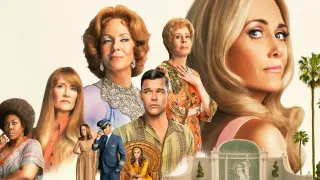October 12, 2021
Music, Menus & Motion: Mill Valley Film Festival Faves
Brian Bromberger READ TIME: 13 MIN.
The Mill Valley Film Festival, presented by the California Film Institute, returns for its 44th year on October 7 and will run through October 17. The festival will remain a hybrid event featuring in-person screenings at the CineArts Sequoia in Mill Valley and the Smith Rafael Film Center in San Rafael, plus virtual online screenings through the CAFILM Streaming Room.
According to its press release, "The 2021 Festival will continue to add to its long-standing reputation of celebrating the best in American Independent and international cinema alongside high-profile and prestigious award contenders and MVFF's tradition of delivering the season's most anticipated films. MVFF prides itself on creating a relaxed and non-competitive atmosphere, giving filmmakers and audiences alike the opportunity to share their work and experiences in a collaborative and convivial spirit."
There are a few LGBTQ offerings, some of which have already been screened at earlier queer festivals. But this year there are three documentaries being presented about game-changing artists who altered their respective fields such that one could say there were before and after periods when these ground-breaking figures first emerged: classical conductor Leonard Bernstein, TV chef Julia Child, and avant-garde rock band The Velvet Underground.
Conduct Becoming
It's hard to overestimate the importance of Leonard Bernstein, as he was the first and most important American classical music conductor of the 20th century, a household name, leading the New York Philharmonic for decades. Douglas Tirola's "Bernstein's Wall" pays homage to this musical genius, but isn't afraid to expose the faults of this eloquent complex man.
There are no talking heads, only Bernstein's own voice telling his own story in his own words, with the use of archival concert material, first-person TV interviews, news footage, home movies, and audio clips.
The documentary begins and ends with Bernstein conducting Beethoven's Ninth Symphony in East Berlin in 1989, celebrating the fall of the Berlin Wall, with him rewriting the "Ode to Joy" movement; the choir substituted the word "freedom" in place of "joy." This was his last triumph before his death at 72 the following year.
Born in 1918 to Jewish parents, Bernstein's tyrannical father was an escapee from a Russian ghetto, who became a successful businessman and wanted Bernstein to follow in his footsteps. However, Bernstein sought a musical career from a young age.
Bernstein attended Harvard but received his principal training during the inaugural year at the Tanglewood Music Center in the Berkshires, summer home of the Boston Symphony Orchestra. He was mentored by his probable lover, Russian conductor Serge Koussevitzky, who advised him to change his Jewish name – a suggestion Bernstein rejected.
Bernstein was hired as the assistant conductor of the NY Philharmonic, and in November, 1943, had the opportunity of a lifetime to replace the ill conductor Bruno Walter, with no rehearsal. Despite partying all night, Bernstein conducted, received a standing ovation, and a review of the concert was featured on the front page of the New York Times, catapulting 25-year-old Bernstein to fame.
Bernstein gave wide-ranging music lectures on the CBS art series "Omnibus" in 1954 and in his 1970s televised series of CBS's "Young People's Concerts," teaching audiences about music and inspiring many students to become musicians.
Bernstein was also mentored by the illustrious gay composer Aaron Copeland in terms of musical composition. He, in turn, mentored younger generations, including gay San Francisco Symphony conductor Michael Tilson Thomas and lesbian first woman Baltimore Symphony conductor Marin Alsop, bequeathing to them his dramatic, "body-possessed by the music" theatrical style of conducting.
Bernstein also composed music for the stage and Hollywood, including "On the Town," "West Side Story," "Candide," "Wonderful Town," and the failure "1600 Pennsylvania Avenue." Little screen time is devoted to this aspect of Bernstein's career, despite his contributions to musical theater being significant. He was asked by Jacqueline Kennedy Onassis to compose a theater piece for the opening of the Kennedy Center in 1971, and his "Mass" received mixed reviews, criticized privately by President Nixon for its liberal political overtones.
Although homosexual, Bernstein had a long, somewhat happy (though complicated) 27-year-marriage to Chilean actress Felicia Montealegre until her 1978 death, siring two children. He had male lovers before, during, and after their marital union.
The film presents forthright excerpts from his letters detailing his "confusion," such as this one to Copeland: "You're the only one who persists and persists, and this wish for closeness manifests itself in a sexual desire, the more promiscuous the better," to which Copeland responded that Bernstein better be careful as he could be blackmailed, advising him to burn any compromising letters. Felicia knew about his sexuality and told him to go off and do what he pleased, "without guilt or confession."
Despite oblique references to affairs with a French Horn player, we learn little about Bernstein's relationships with men, though they appeared to have been mostly transitory.
There's much discussion about Bernstein's leftist political leanings, which resulted in a brief period of being blacklisted in the 1950s (he was briefly denied a passport), but he participated in civil rights marches and anti-Vietnam War protests.
He was ridiculed by Tom Wolfe in an infamous New Yorker article when Bernstein and his wife threw a 1970 party to raise defense funds for the Black Panthers, accusing them of "radical chic," "elegant slumming," a kind of limousine liberalism. Despite the criticism, Bernstein remained dedicated to his progressive activism.
Bernstein's life was so filled with accomplishments, the documentary tends to quickly skip over some highlights. This is one film that could have been longer. While the emphasis on Bernstein's humanitarian and political concerns is laudatory, it comes at the expense of hearing less about his musical accomplishments, unbalancing the film.
Suffering from periods of depression, Bernstein could be cold and cruel at times, but this documentary adopts a compassionate tone to his excesses and flaws, ultimately praising him as a courageous life force, believing art could and should achieve social change.
What's Cooking
Julia Child was not only the country's first celebrity chef, but a cultural icon. In the same vein as their Oscar-nominated documentary "RBG" and their recent "My Name is Pauli Murray" – both about extraordinary women ahead of their time – Betsy West and Julie Cohen have created in "Julia" a tasty portrait about the woman who engineered a cooking revolution in the nation's kitchens.
Prior to Child, most home dinner cuisine was bland convenience foods, TV dinners, frozen meats, canned goods, freeze-dried vegetables, and Jell-O-concocted salads and desserts. Julia challenged women to tackle fresh recipes without fear, starting with French food, and to be open to new cooking experiences.
Julia's story has been told many times, most prominently in the 2009 Nora Ephron-directed film "Julie & Julia," with Meryl Streep starring as Child (oddly, the movie isn't mentioned in "Julia").
To be honest, there isn't much new in "Julia" that we haven't seen previously, but through clips of Julia's TV shows, archival video and audio footage, interviews, and access to Julia's papers, especially her diaries and letters, we get to hear Julia's perspective on her life and career.
She grew up in a wealthy family in Pasadena, and to escape her father's schemes to marry her off quickly, she attended Smith College. She later joined the Office of Strategic Services (forerunner of the CIA) in World War II, not as a spy but a clerk typist, and later a researcher handling top secret material. She met Paul Child in Ceylon; he worked as an OSS spy. Liberal, he was an artist and poet, and he introduced her to fine cuisine and broadened her overall horizons.
In Rouen, France, she ordered sole meuniere at La Couronne and had the equivalent of a culinary orgasm. She decided she wanted to study cooking, and attended the famous Cordon Bleu cooking school in Paris (as the sole woman), then apprenticed with other master chefs.
She spent ten years perfecting the recipes in her landmark book, "Mastering the Art of French Cooking," with co-author Simone Beck. Boston Public TV gave Julia her own cooking show, "The French Chef," which, with her charm, distinctive voice, ability to laugh at her own mistakes (there was no teleprompter and it was sent live-to-tape), and upbeat you-can-do-it-philosophy, became a hit – especially on the first episode, where, due to a technical snafu, she made a perfect omelet on a hot plate.
Many of those early shows look campy now, and Dan Ackroyd famously parodied her on "Saturday Night Live" (which she loved), but she kick-started PBS, as well as inspiring women and gay men to pursue culinary careers. She was tastefully homophobic, but when her gay attorney died of AIDS, she became a gay rights activist (as well as an ardent supporter of Planned Parenthood). She wasn't a big fan of the feminist movement, for which she was criticized, though she told a journalist she was a working woman rarely home before 7:00 pm.
One has to read between the lines here to see her flaws, such as hogging the spotlight from Beck when promoting later editions of "Mastering" fractured their professional relationship. She was not a fan of later generations of cooks, pooh-poohing the farm-to-table movement. She is candid when she reveals that if not for cooking, she would probably have become an alcoholic.
Paul, upon his retirement from the OSS, worked fussily behind the scenes on Julia's TV shows and had a showy lifestyle. While their marriage is portrayed as happy, he's barely mentioned in the documentary, and, candidly, one's gaydar is pinging strongly here, though perhaps he was just an early metrosexual.
As zippy and buoyant as the film is, when one learns family members are the producers and The Julia Child Foundation for Gastronomy and the Culinary Arts was a principal funder, there is the gnawing sense some unpalatable truths may have been swept under the kitchen rug.
Regardless, she was a revolutionary force with a lasting legacy, as we are reminded by culinary experts Ruth Reichl, Ina Garten, and Jose Andres. Some of her signature dishes are newly filmed and look sinfully scrumptious, so don't watch "Julia" on an empty stomach.
True Velvet
To many critics, only the Beatles and The Rolling Stones were more influential rock bands than The Velvet Underground. The boundary-breaking, ahead-of-their-time transgressive Velvet paved the way for punk, new wave, indie, and alternative forms of rock, especially the ones with dark, brooding themes.
They are at last getting the fitting coverage they deserve in gay auteur Todd Haynes' superb, slick documentary "The Velvet Underground." While best known for his feature films "Poison," "Far From Heaven," and "Carol," Haynes has earned musical plaudits for his glam-rock celebration "Velvet Goldmine" and his Bob Dylan biopic "I'm Not There." Thus, it's no surprise that we are treated to an avant-garde documentary to honor this avant-garde band.
Those looking for a linear history of the band will have to look elsewhere, because instead we get to experience Velvet's transcendent experimental music as if we were there in the 1960s, via a documentary that looks the way the band sounded. Haynes uses a constantly-moving, split-screen, multi-media presentation (including experimental animated sequences) and asymmetrical hyper-kinetic montages, mimicking effects inspired by the band's original producer, Andy Warhol, through his art films.
The collage-like kaleidoscopic structure uses archival footage, old photos interspersed with commentary from the band members themselves (in audio interviews for deceased lead singer Lou Reed and guitarist Sterling Morrison), and new interviews with surviving co-founder bassist/violist John Cale and drummer Maureen "Moe" Tucker, as well as comments from colleagues and friends.
Audio recordings of the band's music, including classic songs "Sweet Jane," "Heroin," "Candy Says," "Venus in Furs," "I'm Waiting for the Man," and "Sunday Morning" are scattered throughout the movie. The film also captures the angry underground counterculture (with news clips encapsulating that era) that birthed and nurtured the band, contributing to its creative innovation.
The Velvet Underground came to prominence performing in Warhol's Exploding Plastic Inevitable (psychedelic) Shows, and became full participants in The Factory lifestyle. Warhol gave them freedom to improvise and shielded them from meddling record industry-types, insisting only that they include the icy German chanteuse singer Nico on their first album in 1967 (which Reed resented), with cover art designed by Warhol.
Reed and Cale had met at legendary 56 Ludlow Street (Lower East Side), a haven for counterculture artists, both charismatic but with different visions of how the group should proceed. Reed was mentally ill most of his life, plagued by depression and panic attacks, which he self-treated with heavy drug use. He was primarily gay and deeply conflicted, such that, according to Reed, he was sent to electroconvulsive therapy by his parents to suppress his homosexuality, a claim disputed by his sister Merrill.
Still, Reed, influenced by Rimbaud, Ginsberg, Baudelaire, Burroughs, Selby, and Delmore Schwartz, would write homoerotic poetry often about having sex with men in public bathrooms. He sought to transform their prose into rock music. He also played gigs with teenage bands at the Long Island gay bar Hayloft, because they were a "cool bunch of people." This was all fueled by his destructive heroin addiction.
All these experiences contributed to his confrontational, raging, wounded, trippy, drug-laced, anarchic, non-conformist lyrics about orgiastic sex, junkies, whores, drag queens, and other denizens of sordid street life juxtaposed with strange, tender, intoxicating melodies.
As quoted by Tucker, the band rejected hippie culture: "this love-peace crap – we hated that." Cale meanwhile was influenced by John Cage and La Monte Young's eastern hypnotic slow tempo drone-sounding music with chord variations.
The two leads were fiercely jealous of each other, with the increasingly sullen, insecure, antagonistic Reed's ultimatum after their first album – it's me or him – resulting in Cale leaving. Ultimately Reed abruptly exited the band to go solo after they performed at Max's Kansas City club in 1970.
Never commercially successful at the time, their legendary reputation has soared ever since the breakup. The documentary at first can seem disorienting to the viewer, but gradually you adapt and are entranced by Haynes interdisciplinary approach. We begin to understand Velvet's mythic status as outsiders, and why their ground-breaking, elusive, at times discordant sound changed rock forever. You won't be able to resist playing their music or watching vintage YouTube performance videos once the final frame of this thrilling documentary disappears.
Note: "Velvet Underground" opens in theaters October 15 and will be streamed on Apple + TV.
Stepping Out
I would be remiss in not highly recommending a short 25-minute entry "God's Daughter Dances," a Bay Area premiere, from South Korea. Transgender dancer Shin-mi is a success at a local nightclub, producing some diehard groupies.
But the next morning she must report for a military examination. The doctor doubts she is transgender despite her paperwork, and wants her to strip naked to prove she's a woman and not a man faking to get out of compulsory military service.
There is a surprise connection linking her dancing with the military. How Shin-mi responds to various indignities is thrilling, and she will become a new queer role model. Enchanting and empowering, "God's Daughter Dances" will inspire transgender people of all cultures.
Help keep the Bay Area Reporter going in these tough times. To support local, independent, LGBTQ journalism, consider becoming a BAR member.






